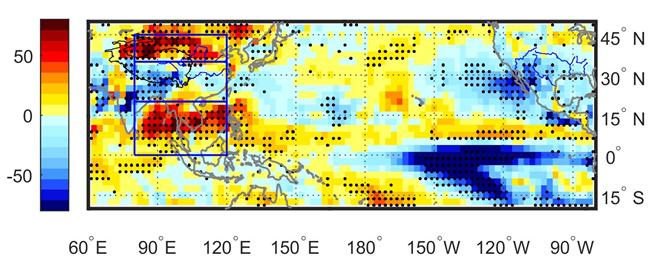【中文介绍】
冬春季青藏高原积雪可以直接影响海陆热力差异,是东亚夏季风的主要驱动因子。过去几十年,东亚夏季风系统在20世纪70年代末和90年代末发生了显著的年代际变化,同时分别伴随青藏高原积雪的显著增加和减少。虽然关于东亚夏季风年代际变化的可能机制已有大量研究,高原积雪是其中一个主要影响因素,但是关于高原冬季积雪年代际变化机制的认识还相当缺乏。
高原冬季降雪是冬季积雪的主要影响因素。因此,针对20世纪90年代末青藏高原冬季降雪显著减少的现象,中国科学院大气物理研究所的祝亚丽副研究员利用观测数据和数值模拟开展了研究。结果发现,90年代末前后,高原及周边地区冬季降水出现了三极型的空间变化模态,高原主体上空降水减少,南北两侧降水增加(图1)。进一步通过对比观测和模拟结果,发现热带太平洋的海温变化可以引起太平洋地区沃克环流增强,导致印太交汇区出现垂直上升运动异常,进而引起局地经向环流变化,加上东亚西风急流减弱并往西北移动,使得高原及周边冬季降水发生三极型的变化模态。全球变暖背景下,高纬气候系统如海冰,以及人类活动对高原降水年代际变化的影响,是值得进一步研究的问题。
【英文介绍】
Classical monsoon dynamics considers the winter/spring snow amount on the Tibetan Plateau (TP) as a major factor driving the East Asian summer monsoon (EASM) for its direct influence on the land–sea thermal contrast. Actually, the TP snow increased and decreased after the late 1970s and 1990s, respectively, accompanying the two major interdecadal changes in the EASM. Although studies have explored the possible mechanisms of the EASM interdecadal variations, and change in TP snow is considered as one of the major drivers, few studies have illustrated the underlying mechanisms of the interdecadal changes in the winter TP snow. This study reveals a tripole pattern of change, with decreased winter precipitation over the TP and an increase to its north and south after the late 1990s (Figure 1). Further analyses through numerical experiments demonstrate that the tropical Pacific SST changes in the late 1990s can robustly affect the winter TP precipitation through regulating the Walker and regional Hadley circulation. The cooling over the tropical central-eastern Pacific can enhance the Walker circulation cell over the Pacific and induce ascending motion anomalies over the Indo-Pacific region. These anomalies further drive descending motion anomalies over the TP and ascending motion anomalies to the north through regulating the regional Hadley circulation. Therefore, the positive–negative–positive winter precipitation anomalies around the TP are formed. This study improves the previously poor understanding of TP climate variation at interdecadal timescales.
【关键图表】

【引用格式】
Yali Zhu, 2022, A tripole winter precipitation change pattern around the Tibetan Plateau in the late 1990s, Atmospheric and Oceanic Science Letters, 100223. https://doi.org/10.1016/j.aosl.2022.100223.









